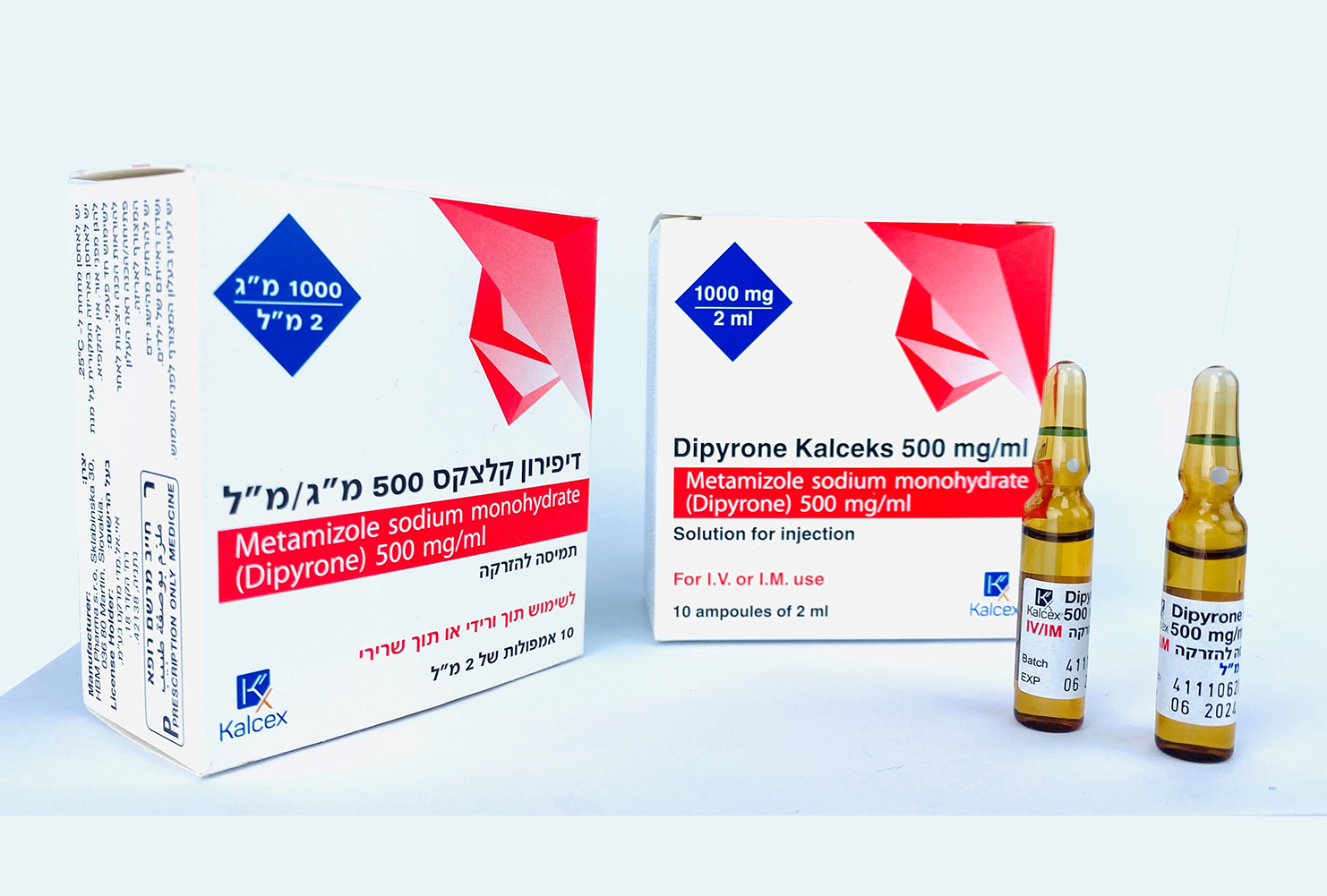Quest for the right Drug

דיפירון קלצקס 500 מ"ג/מ"ל DIPYRONE KALCEKS 500 MG/ML (METAMIZOLE SODIUM MONOHYDRATE)
תרופה במרשם
תרופה בסל
נרקוטיקה
ציטוטוקסיקה
צורת מתן:
תוך-שרירי, תוך-ורידי : I.M, I.V
צורת מינון:
תמיסה להזרקה : SOLUTION FOR INJECTION
עלון לרופא
מינוניםPosology התוויות
Indications תופעות לוואי
Adverse reactions התוויות נגד
Contraindications אינטראקציות
Interactions מינון יתר
Overdose הריון/הנקה
Pregnancy & Lactation אוכלוסיות מיוחדות
Special populations תכונות פרמקולוגיות
Pharmacological properties מידע רוקחי
Pharmaceutical particulars אזהרת שימוש
Special Warning עלון לרופא
Physicians Leaflet
Adverse reactions : תופעות לוואי
4.8 Undesirable effects The frequency of undesirable effects is stated on the basis of the following categories: Very common ≥ 1/10 Common ≥ 1/100, < 1/10 Uncommon ≥ 1/1000, < 1/100 Rare ≥ 1/10,000, < 1/1000 Very rare < 1/10,000 Not known Frequency cannot be estimated from the available data Blood and lymphatic system disorders Rare: Leucopenia. Very rare: Agranulocytosis, including cases with a fatal outcome, thrombocytopenia. Not known: Aplastic anaemia, pancytopenia, including cases with a fatal outcome. These reactions can occur even if dipyrone has previously been administered without complications. There are isolated reports suggesting that the risk of agranulocytosis may possibly be increased if Dipyrone Kalceks 500 mg/ml solution for injection is administered for longer than a week. This reaction is not dose-dependent and can occur at any time during treatment. It manifests as high fever, shivering, sore throat, swallowing difficulties and inflammation of the mouth, nose, throat, genitals or anal regions. In patients receiving antibiotics, however, these signs may be minimal. Swelling of lymph nodes or the spleen is minor or completely absent. The erythrocyte sedimentation rate is greatly increased and granulocytes considerably reduced or completely absent. In general, but not always, haemoglobin, erythrocyte and platelet values are normal (see section 4.4). Immediate cessation is crucial to recovery. It is therefore urgently recommended to stop Dipyrone Kalceks 500 mg/ml solution for injection immediately, without waiting for the laboratory results, if an unexpected deterioration in the patient’s general condition occurs, the fever does not subside or recurs, or painful changes occur in the mucosa, especially in the mouth, nose and throat. Typical signs of thrombocytopenia include an increased bleeding tendency and petechiae on the skin and mucosae. If pancytopenia occurs, the treatment must be stopped immediately and the full blood count monitored until it normalises (see section 4.4). Immune system disorders Rare: Anaphylactoid or anaphylactic reactions*. Very rare: Analgesic-induced asthma syndrome. In patients with analgesic asthma syndrome, intolerance reactions typically appear in the form of asthma attacks. Not known: Anaphylactic shock*. *These reactions can occur especially after parenteral administration, can be serious and life-threatening, and in some cases have a fatal outcome. They can occur even if dipyrone has previously been administered without complications. Such reactions can develop during the injection or immediately after ingestion, but also hours later. However, in the majority of cases, they occur during the first hour after administration. Milder reactions typically manifest as skin and mucous membrane reactions (e.g., itching, burning, reddening, urticaria, swelling), dyspnoea and rare gastrointestinal symptoms. Milder reactions of this kind can transition into more severe forms with generalised urticaria, severe angio-oedema (including laryngeal), severe bronchospasm, arrhythmias, hypotension (sometimes preceded by a rise in blood pressure) or circulatory shock. Dipyrone Kalceks 500 mg/ml solution for injection must therefore be stopped immediately if skin reactions occur. Cardiac disorders Not known :Kounis syndrome. Vascular disorders Uncommon: Hypotensive reactions during or after administration which are possibly pharmacological in origin and not accompanied by other signs of an anaphylactoid or anaphylactic reaction. Such a reaction can lead to severe hypotension. Rapid intravenous injection increases the risk of a hypotensive reaction. Even in cases of hyperpyrexia, dose-dependent critical hypotension can occur without other signs of a sensitivity reaction. Gastrointestinal disorders Not known: Cases of gastrointestinal bleeding have been reported. Hepatobiliary disorders Not known: Drug-induced liver damage including acute hepatitis, jaundice, raised liver enzymes (see section 4.4) Skin and subcutaneous tissue disorders Uncommon: Fixed drug eruption. Rare: Rash (e.g., maculopapular rash). Very rare: Stevens-Johnson syndrome or toxic epidermal necrolysis (see section 4.4). Not known: Drug reaction with eosinophilia and systemic symptoms (DRESS, see section 4.4). Renal and urinary disorders Very rare: Acute deterioration of kidney function in which, very rarely, proteinuria, oligo- or anuria or acute kidney failure can develop; acute interstitial nephritis. General disorders and administration site conditions If the product is injected, pain and local reactions, very rarely even phlebitis, can occur at the injection site. Red discoloration of the urine has been reported; this may be caused by the harmless dipyrone metabolite rubazonic acid, which is present at a low concentration. Reporting of suspected adverse reactions Reporting suspected adverse reactions after authorization of the medicinal product is important. It allows continued monitoring of the benefit/risk balance of the medicinal product. Any suspected adverse events should be reported to the Ministry of Health according to the National Regulation by using an online form http://sideeffects.health.gov.il

שימוש לפי פנקס קופ''ח כללית 1994
לא צוין
תאריך הכללה מקורי בסל
לא צוין
הגבלות
לא צוין
מידע נוסף
